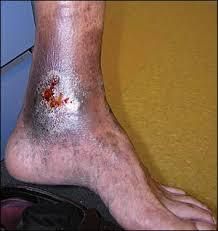If you or someone you care for has a sore or wound on the lower leg that just won’t go away — especially around the ankle — don’t ignore it. What might look like a simple scrape or irritation could be something much more serious: a venous leg ulcer.
At South Bay Vascular Center and Vein Institute, Dr. Polly Kokinos sees this every day. What starts as a dry patch or scab ends up becoming an open sore that refuses to heal. Often misdiagnosed or ignored, these ulcers are a key warning sign of vein disease — a condition that requires expert care to avoid worsening problems, including infection and even amputation.
What Is a Venous Leg Ulcer?
A venous leg ulcer is an open wound that develops because of poor blood flow through the veins in your legs. When the valves inside your veins stop working properly, blood pools near the ankles. This increased pressure causes skin to weaken and break down.
These ulcers typically appear:
– Around the inner ankle
– After a minor injury or bump
– With symptoms like swelling, aching, or skin discoloration
Why These Wounds Don’t Heal On Their Own
Unlike a cut or scrape that closes up in a few days, venous ulcers don’t heal because blood isn’t flowing correctly. The skin stays inflamed and weak. Over-the-counter creams won’t fix the problem — and in fact, waiting too long can make things worse.
Common signs it’s a venous ulcer:
– The wound’s been there more than 2 weeks
– It gets red, weepy, or has a yellow film
– The area around the wound smells or is warm to the touch
– The sore starts small and slowly gets bigger
Dr. Polly Kokinos: Fighting to Save Limbs in Santa Clara County
At South Bay Vascular, Dr. Kokinos leads the fight to save legs from unnecessary amputations caused by undiagnosed vein disease. She’s a board-certified vascular surgeon who works with diabetic patients, seniors, and those told there’s “nothing more to do.”
What sets her apart?
✔️ On-site vein ultrasound diagnostics
✔️ In-office procedures that don’t require a hospital stay
✔️ Immediate access to wound care and vascular services
✔️ Compassionate, clear explanations every step of the way
Real Patients. Real Results.
“My dad’s sore was getting worse every day. We had no idea it was vein-related until Dr. Kokinos stepped in. She saved his leg.”
— Grace Y., San Jose
“I kept wrapping it up with bandages, but it wouldn’t heal. I wish I’d gone to her sooner.”
— Oscar V., Gilroy
Don’t Wait Until It’s Too Late
If you or a loved one has a wound near the ankle that won’t heal, don’t chalk it up to age or diabetes. These are warning signs of a deeper issue — one that can lead to hospitalization or even limb loss if left untreated.
📞 Call South Bay Vascular at (408) 376-3626 today to schedule an appointment with
Dr. Polly Kokinos.
Confident Legs, Confident Life. There’s help. And there’s hope.
